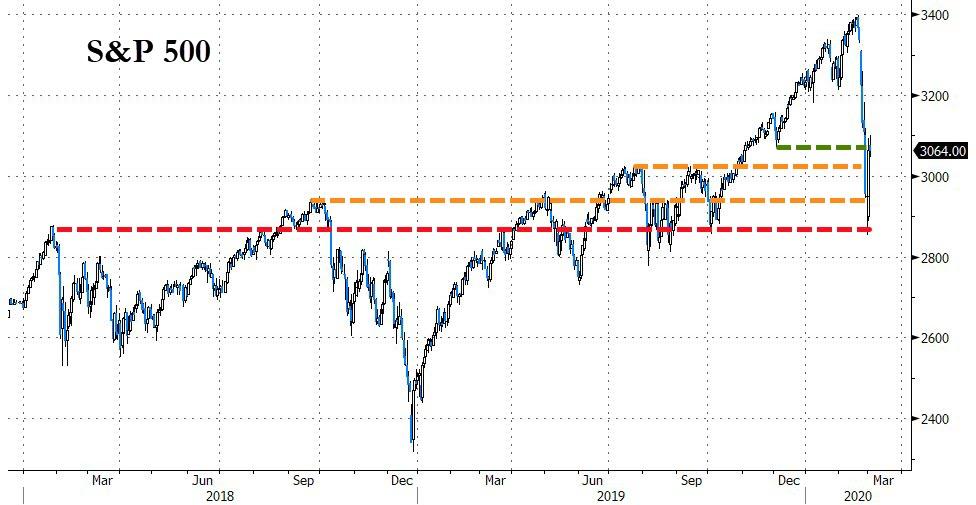
Panic in the "save stocks at all costs" world was evident yesterday, but, as Bloomberg's Richard Breslow explains, it's way too early to be in awe of this bounce...
People are rightly rattled by the threats stemming from the coronavirus. The risk of getting seriously ill certainly focuses the mind. The way equity, credit and yields behaved over the last couple of weeks, it appeared clear that financial markets had gotten a similar message as to its seriousness. Economic forecasts were being dramatically cut and it was hard to fathom how supply chains could be sustained. The extent and immanence of recession risk was a major topic of debate. The new OECD outlook practically merited banner headlines.
We know public health officials and governments trying to protect their citizens remain as concerned as before. Drug companies are scrambling to find a vaccine. Daily interactions have been radically altered. Would you sit down next to someone coughing or sneezing while making the daily commute? The question is, are investors already over it?
Or is this the kind of sell-off - and now bounce - that illustrates why economists continue to debate market efficiency and over-reactions?

As Nobel laureate Robert Shiller argued, "Prices fluctuate too much to be explained by a rational process." We all remember, or at least have read about, the market crash of October 1987. What sticks in everyone's mind was the 22.6% one-day fall. What is less often discussed is that the next two sessions were big up days.
It's far less likely that a true bear market can be sustained without a recession. Like now, back in 1987, predictions that we were headed for one were widely professed. It didn't happen. Central banks swooped in providing liquidity and support for the banks. And while it was traumatic, the effects were relatively short-lived. That's the model that policy makers are hoping will be applicable again.
But this one is different.
The shock and awe approach of a coordinated response is certainly having an effect on asset prices. Ultimately, to work, however, they need to find a response that addresses the severity of the disease across populations. And time is of the essence when projecting the length of time it affects the global economy.
Cutting rates is a necessary, but not sufficient response. It makes the initial insistence that this would all be short-lived all the more understandable. Perhaps being overly cynical, why putting that insistence in abeyance while waiting for them to schedule the emergency G-7 conference call and why we are most likely to start hearing about it again after the market gets what it wants
Stocks got hit hard since the latter part of January. Yet they closed last Friday, the last day of the month, above a key long-term technical level. Monday speaks for itself and, given the magnitude of the rally, the S&P 500 got back above the much-watched 200-day moving average. And has added some additional cushion so far today, at least in futures. We now have a slew of technical levels to lean on, both short and long-term. That should, in theory, make things less frenetic.

There was one group of traders who clearly had a firm understanding of central bank reaction functions. Hedge funds were apparently buying last week's dip.
And did so with gusto. Now we'll try to find out what they are going to do with them.
The real question will be if equities have coattails. As far as emerging markets are concerned it is simply too early to tell. They don't enjoy the insulation of some of the more developed markets. The same can be said for the components of the Bloomberg Commodity Index. And the much maligned dollar is bending but has not broken, despite the severity of the recent move. DXY has a lot of support all the way down to 96.
This is a time where caution should still be the order of the day.
Extrapolating the latest moves, down or up, is a dicey proposition. Risk perception can often be merely a function of price movements rather than careful analysis. Expected returns are a lot more difficult to forecast given present events and, unlike the assumptions in simplistic models, we know they change, and can do so meaningfully. That's why this is more than just a financial crisis.
Commenti
Posta un commento